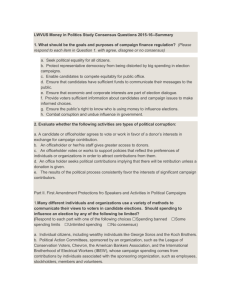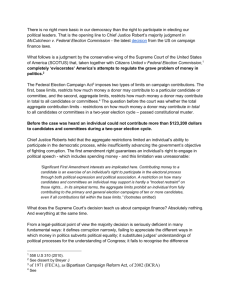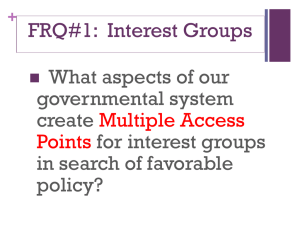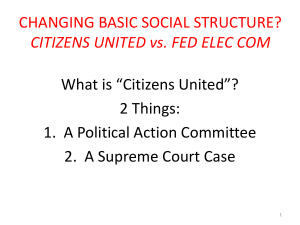word
advertisement
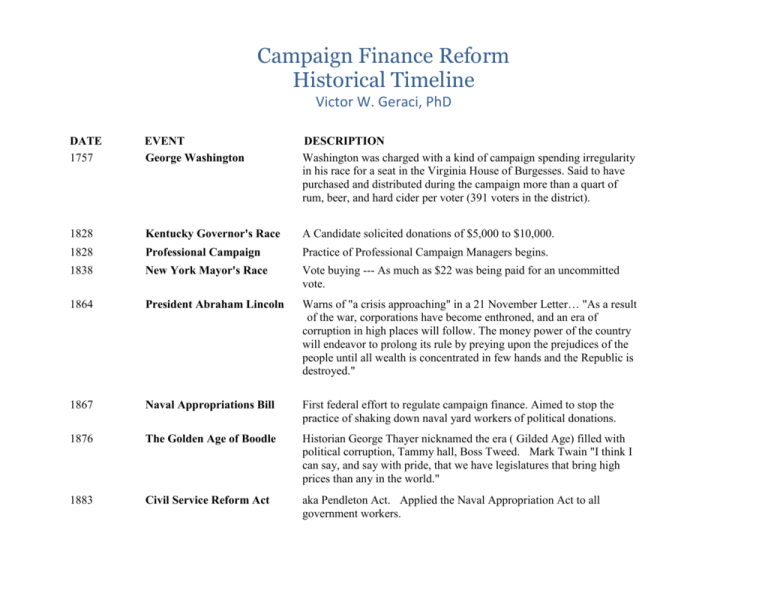
Campaign Finance Reform Historical Timeline Victor W. Geraci, PhD DATE 1757 EVENT George Washington DESCRIPTION Washington was charged with a kind of campaign spending irregularity in his race for a seat in the Virginia House of Burgesses. Said to have purchased and distributed during the campaign more than a quart of rum, beer, and hard cider per voter (391 voters in the district). 1828 Kentucky Governor's Race A Candidate solicited donations of $5,000 to $10,000. 1828 Professional Campaign Practice of Professional Campaign Managers begins. 1838 New York Mayor's Race Vote buying --- As much as $22 was being paid for an uncommitted vote. 1864 President Abraham Lincoln Warns of "a crisis approaching" in a 21 November Letter… "As a result of the war, corporations have become enthroned, and an era of corruption in high places will follow. The money power of the country will endeavor to prolong its rule by preying upon the prejudices of the people until all wealth is concentrated in few hands and the Republic is destroyed." 1867 Naval Appropriations Bill First federal effort to regulate campaign finance. Aimed to stop the practice of shaking down naval yard workers of political donations. 1876 The Golden Age of Boodle Historian George Thayer nicknamed the era ( Gilded Age) filled with political corruption, Tammy hall, Boss Tweed. Mark Twain "I think I can say, and say with pride, that we have legislatures that bring high prices than any in the world." 1883 Civil Service Reform Act aka Pendleton Act. Applied the Naval Appropriation Act to all government workers. 1896 1905 1907 910 1913 Election President Roosevelt Calls for Reform Tillman Act Watershed for Campaign Finance … set the record for expenditures, unsurpassed for the next quarter century. McKinley = $7 million, Bryan = $650,000…Marcus Alonzo Hanna, Ohio businessman and chairman of the Republican national Committee, introduced the practice of regularly assessing businesses for campaign contributions, and began the practices of political advertising, regular press releases, speakers, posters, buttons, and billboards. 300,000 flyers in 9 different languages. President Theodore Roosevelt argued for a ban on all political contributions by corporations. Also proposed a public financing system for all federal candidates. President Theodore Roosevelt called for public financing of federal candidates via political parties and congress responded with the Act to ban bank and corporate giving. The ban was largely ignored. Federal Corrupt Practices Act First comprehensive reform measure. Established the first disclosure requirements for federal candidates and limited the spending by House and Senate candidates. 17th Amendment Direct election of Senators. Expansion of the Electorate and importance of the common voter to the overall process; thus, requiring more campaign financing. 1920 19th Amendment Women's Suffrage. Expansion of the Electorate and importance of the common voter to the overall process; thus, requiring more campaign financing. 1924 Democratic Party Campaign The Party campaign plank sponsored by William Jennings Bryan, called for federal candidates to be furnished "reasonable means of publicity at public expense." 1925 Amendment to Federal Corrupt Served as the basic campaign finance act until 1971. Act was devoid of Practices Act any enforcement procedures. Strengthen the disclosure requirements and caps spending. President LBJ referred to the law as "more loophole than law." 1935 Hatch Act Congress prohibited contributions to federal candidates from federal workers and contractors and limited individual contributions to $5,000 per year. 1936 Labor Contributions to Campaigns CIO president John L. Lewis contributes $500,000 to the Democratic Party. 1943 Smith-Connally Act Prohibited Labor Unions drom directly contributing money to federal candidates. 1944 CIO first PAC 1947 Taft-Hartley Act In response to the Smith-Connally Act the CIO formed the first Political Action committee (PAC) funded through voluntary contributions and not union treasury funds. Permanent ban on contributions to federal candidates from unions, corporations, and interstate banks. 1950 Electronic Campaigning Between 1956 and 1968 campaign spending doubles from $155 million to over $300 million as outlays for broadcast media increased six fold, from $10 million to $60 million. 1968 Campaign Contributions 8 percent of the voting population gave contributions to local, state, and federal candidates. 1971 FECA Federal Elections Campaign Act - Congress passes the act to set limits on and require disclosure of spending by candidates for federal offices and provides for financing for Presidential campaigns. Required full and timely disclosures, limited some contributions, capped spending, and permitted unions and corporations to form PACs. 1971 Revenue Act Established the public financing system for qualifying presidential candidates paid for by the voluntary $1.00 check off on income tax forms. Also provided $50.00 tax deduction for individual contributions (ended 1978) or $12.50 tax credit9 raised to $50.00 in 1978 and eliminated in 1986). 1972 Watergate Election President Richard Nixon's reelection committee received million of dollars in secret. IE Robert Vesco ($200,000 in a briefcase), Howard Hughes ($100,000 in a safe deposit box), Clement Stone ($2 million), 13 corporations $780,000 in illegal corporate contributions. 1974 Federal Election Commission FECA - After the Nixon Watergate scandal Congress creates the commission to enforce the Federal Election Campaign Act provisions. Create $1,000 individual contribution limit and a $5,000 PAC limit. 1976 Buckley v. Valeo 424 US 1 Supreme Court ruling that mandatory spending limits violate free speech mandates. 1976 FECA Amendments Congress enacts new amendments to FECA to comply with Buckley v. Valeo. 1978 General Election Spending General election totals equal $153.5 million. 1979 FECA Amendments Package of amendments to the election campaign act allows the use of donations to political parties rather than candidates. First time Congress enacted reform. 1980 General Election Spending General election spending totals $192.1 million. 1985 FEC v. National Conservative 470 US 480 NCPAC extended Buckley's ruling that independent expenditures could not be limited. 1986 Bills Killed The US Senate votes twice in favor of strict controls for campaign fundraising but bipartisan maneuvers do not allow the bills to come up for a vote. 1986 General Election Spending General election Spending reaches $400.9 million. 1988 General Election Spending General Election Spending reaches $408.3 million. 1988 Legislative and Legal Setbacks A proposal for limiting overall Campaign spending by candidates is shelved after a Republican Filibuster. A constitutional amendment to override the Supreme Court decision fails to get off the ground. 1990 Austin v. Michigan State Chamber of Commerce 494 US 652. Austin affirmed the constitutionality of a ban on campaign spending by business corporations or other corporations other than purely non-profit. 1990 1990 General Election Spending More legislative Failure General Election Spending reaches $403.7 million. The House and Senate approve voluntary spending limits and restrictions on political action committees. Conferees fail to resolve differences and bill never sent to President Bush. 1992 Bush Vetoes Campaign Limits Bill President Bush vetoed a bill providing partial public financing for congressional candidates who abide by voluntary fund-raising ceilings and baring soft money contributions to Presidential candidates. Senate fails to override the veto. 1992 Campaign Contributions 4 percent of the voting population gave contributions to local, state, and federal candidates. 80 percent of all congressional campaign money donated by PACs and individuals giving $200 or more. 1992 General Election Spending General Election Spending reaches $528.6 million. 1994 General Election Spending General Election Spending reaches $616.2 million 1994 More Bills Blocked Republicans again block a bill setting spending limits and authorizing partial public financing of congressional elections. 1996 General Election Spending General Election Spending reaches $650.8 million. 1996 More Bills Fail Bipartisan legislation for voluntary spending limits with rewards for those who comply and baring soft money is killed by a Republican filibuster. 1997 Bill Fails McCain- Feingold bipartisan bill to close soft money and TV advertising expenditures runs afoul of a Republican filibuster. Senate sets March 1998 deadline for another vote on the bill. 1999 Campaign Integrity Act Asa Hutchinson (R - Arkansas) Bill to ban soft money and raise hard HR:1867 money limits. Campaign Reform and Election Sponsored by Rep. Bill Thomas (R - CA) includes a ban on foreign Integrity Act money and reforms the FEC. 1999 1999 Citizen Legislature & Political HR 1922 sponsored by Rep. John Doolittle (R - CA) to repeal all Freedom Act federal election contribution limits and expedite and expand disclosure. 1999 HR: 417 Campaign Reform Act Shays-Meehan Bill, sponsored by Christopher Shays (R - CT) and Martin Meehan (D - MA) to ban soft money and limit types of campaign advertising. 2002 Bipartisan Campaign Reform Act Sponsored by Senators Russell Feingold (D-WI) and John McCain (R-AZ). Revised some of the legal limits of expenditure set in 1974, and prohibited unregulated contributions (called "soft money") to national political parties. Also defined political ads as "electioneering communications" prohibiting any such ad paid for by a corporation or paid for by an unincorporated entity using any corporate or union funds 2003 Supreme Court Upholds BCRA A divided Supreme Court upholds the Bipartisan Campaign Reform Act, which had been challenged by both parties. The decision preserved the soft money ban and restrictions on political ads, which were the most significant parts of the law. 2006 U.S. Supreme Court Decision Right to Life v. FEC Certain advertisements might be constitutionally entitled to an exception from the electioneering communications' provisions of McCain-Feingold. The Court established a broad exemption for any ad that could have a reasonable interpretation as an ad about legislative issues. 2006 the Randall v. Sorrell The Supreme Court of the United States ruled that Vermont's law, the strictest in nation which placed a cap on financial donations made to politicians, unconstitutionally hindered the citizens' First Amendment right to free speech. A key issue in the case was the 1976 case Buckley v. Valeo, which many justices felt needed to be revisited 2007 BCRA Loosens The Supreme Court, in a 5-4 decision, ruled that advocacy groups financed by unions or corporate money could not be barred from running ads in the month before a primary and the two months preceding a general election. The court gave greater latitude to what an issue ad could say 2012 Citizens United v. FEC The ruling allows corporations and unions to advocate for or against candidates at any time. Two months later, in Speechnow.org v. FEC, an appeals court strikes down limits on contributions to independent-expenditure shops. The super-PAC is born.


